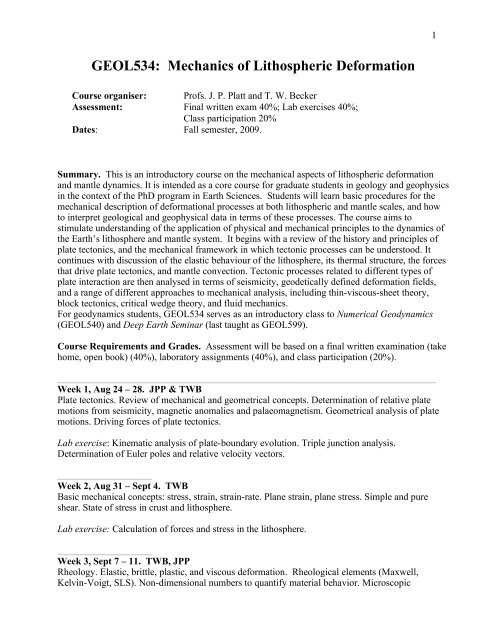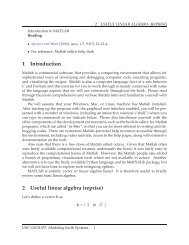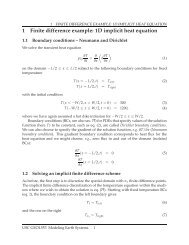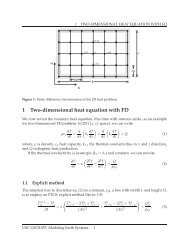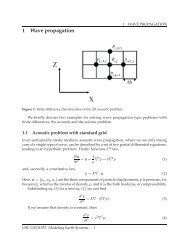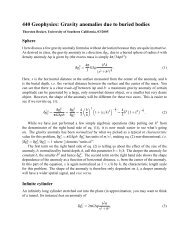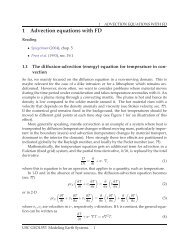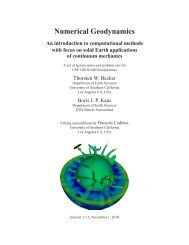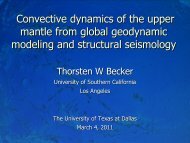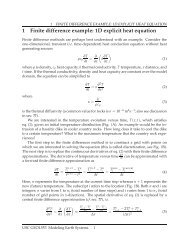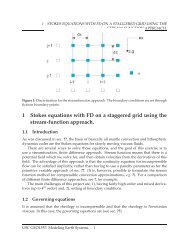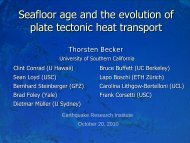Mechanics of Lithospheric Deformation - USC Geodynamics
Mechanics of Lithospheric Deformation - USC Geodynamics
Mechanics of Lithospheric Deformation - USC Geodynamics
Create successful ePaper yourself
Turn your PDF publications into a flip-book with our unique Google optimized e-Paper software.
1<br />
GEOL534: <strong>Mechanics</strong> <strong>of</strong> <strong>Lithospheric</strong> <strong>Deformation</strong><br />
Course organiser: Pr<strong>of</strong>s. J. P. Platt and T. W. Becker<br />
Assessment: Final written exam 40%; Lab exercises 40%;<br />
Class participation 20%<br />
Dates: Fall semester, 2009.<br />
Summary. This is an introductory course on the mechanical aspects <strong>of</strong> lithospheric deformation<br />
and mantle dynamics. It is intended as a core course for graduate students in geology and geophysics<br />
in the context <strong>of</strong> the PhD program in Earth Sciences. Students will learn basic procedures for the<br />
mechanical description <strong>of</strong> deformational processes at both lithospheric and mantle scales, and how<br />
to interpret geological and geophysical data in terms <strong>of</strong> these processes. The course aims to<br />
stimulate understanding <strong>of</strong> the application <strong>of</strong> physical and mechanical principles to the dynamics <strong>of</strong><br />
the Earth’s lithosphere and mantle system. It begins with a review <strong>of</strong> the history and principles <strong>of</strong><br />
plate tectonics, and the mechanical framework in which tectonic processes can be understood. It<br />
continues with discussion <strong>of</strong> the elastic behaviour <strong>of</strong> the lithosphere, its thermal structure, the forces<br />
that drive plate tectonics, and mantle convection. Tectonic processes related to different types <strong>of</strong><br />
plate interaction are then analysed in terms <strong>of</strong> seismicity, geodetically defined deformation fields,<br />
and a range <strong>of</strong> different approaches to mechanical analysis, including thin-viscous-sheet theory,<br />
block tectonics, critical wedge theory, and fluid mechanics.<br />
For geodynamics students, GEOL534 serves as an introductory class to Numerical <strong>Geodynamics</strong><br />
(GEOL540) and Deep Earth Seminar (last taught as GEOL599).<br />
Course Requirements and Grades. Assessment will be based on a final written examination (take<br />
home, open book) (40%), laboratory assignments (40%), and class participation (20%).<br />
Week 1, Aug 24 – 28. JPP & TWB<br />
Plate tectonics. Review <strong>of</strong> mechanical and geometrical concepts. Determination <strong>of</strong> relative plate<br />
motions from seismicity, magnetic anomalies and palaeomagnetism. Geometrical analysis <strong>of</strong> plate<br />
motions. Driving forces <strong>of</strong> plate tectonics.<br />
Lab exercise: Kinematic analysis <strong>of</strong> plate-boundary evolution. Triple junction analysis.<br />
Determination <strong>of</strong> Euler poles and relative velocity vectors.<br />
Week 2, Aug 31 – Sept 4. TWB<br />
Basic mechanical concepts: stress, strain, strain-rate. Plane strain, plane stress. Simple and pure<br />
shear. State <strong>of</strong> stress in crust and lithosphere.<br />
Lab exercise: Calculation <strong>of</strong> forces and stress in the lithosphere.<br />
Week 3, Sept 7 – 11. TWB, JPP<br />
Rheology. Elastic, brittle, plastic, and viscous deformation. Rheological elements (Maxwell,<br />
Kelvin-Voigt, SLS). Non-dimensional numbers to quantify material behavior. Microscopic
2<br />
deformation mechanisms: Elasticity, diffusion creep, dislocation creep. Byerlee's “law”.<br />
<strong>Deformation</strong> maps. Strength pr<strong>of</strong>iles in crust and lithosphere.<br />
Lab exercise: Rheology <strong>of</strong> the upper mantle.<br />
Week 4, Sept 14 – 18. No meeting: SCEC.<br />
Week 5, Sept 21 - 25. JPP<br />
Displacement gradients, rotation, and strain. Velocity gradients, vorticity, and strain-rate. Direct<br />
measurement <strong>of</strong> the velocity field using GPS. Determination <strong>of</strong> fault slip vectors from seismic focal<br />
mechanisms. Seismic moment. Determination <strong>of</strong> strain-rates from the seismic moment tensor and<br />
from fault slip-vector data.<br />
Lab exercise: Determination <strong>of</strong> rates <strong>of</strong> strain and rotation from geodetic data.<br />
Week 6, Sept 28 – Oct 2. JPP<br />
Buckling and flexure <strong>of</strong> an elastic plate. Concept <strong>of</strong> effective elastic thickness <strong>of</strong> lithosphere. Flexural<br />
moat and peripheral bulge around seamounts. Flexural origin <strong>of</strong> deep-sea trenches. Flexural<br />
(foreland) basins in front <strong>of</strong> thrust belts.<br />
Lab exercise: Determination <strong>of</strong> effective elastic thickness from surface topography and gravity data.<br />
Week 7, Oct 5 – 9. TWB<br />
Thermal structure <strong>of</strong> the lithosphere. Heat flow, steady state geotherms. Time-variable conductive<br />
solutions. Half-space cooling and thermal subsidence <strong>of</strong> oceanic lithosphere: relationship between<br />
bathymetry and heat flow. Definition <strong>of</strong> lithosphere in terms <strong>of</strong> mechanical and thermal boundary<br />
layers.<br />
Lab exercise: Calculation <strong>of</strong> plate driving forces<br />
Week 8, Oct 12 – 16. TWB<br />
Fluid dynamics, channel flow and Stokes problem. Thermal convection. Boundary layer theory.<br />
Linear stability analysis. Numerical solutions <strong>of</strong> the thermal convection equation.<br />
Reading: Rayleigh Tayleigh instability.<br />
Week 9, Oct 19 - 23. TWB<br />
Thermal state <strong>of</strong> the Earth. Adiabatic gradient. Global heat budgets. Oceanic plate tectonics.<br />
Structure <strong>of</strong> oceanic and continental crust and lithosphere. Ridges: active and passive spreading,<br />
melting extent and geometry, axial highs and axial lows. Transform fault boundaries: segmentation,<br />
leaky transformss (flower structures, pull-apart basins), micro-plates. Subduction zones: seismicity,<br />
slab structure. Plumes and hotspots.
3<br />
Lab exercise: Gravitational potential energy <strong>of</strong> a mid-ocean ridge.<br />
Week 10, Oct 26 – 30. JPP<br />
Velocity distribution around continental transforms: thin viscous sheet versus elastic dislocation<br />
models. Continental transform faults. Block models, and the role <strong>of</strong> vertical axis rotations.<br />
Lab exercise: Analysis <strong>of</strong> the velocity field across the San Andreas fault zone<br />
Week 11, Nov 2 – 6. TWB<br />
Transient deformation along transform faults. Large scale time-dependent deformation, post-glacial<br />
adjustment, uplift, geoid. Constraints on the viscosity <strong>of</strong> upper crust, lower crust and lithosphere.<br />
Discussion session: Creme Brulee vs. Jelly Sandwich views <strong>of</strong> the lithosphere<br />
Week 12, Nov 9 – 13. JPP<br />
Continental extension. McKenzie model for extensional basins, predicted thermal structure and<br />
subsidence history. Implications and tests <strong>of</strong> more complicated models <strong>of</strong> crustal and lithospheric<br />
extension.<br />
Lab exercise: Backstripping exercise to determine thermal subsidence history.<br />
Week 13, Nov 16 - 20. JPP<br />
Mechanical descriptions <strong>of</strong> continental collision: indentation/extrusion models, thin-sheet models.<br />
Behaviour <strong>of</strong> sub-continental mantle in collision zones. Plateau uplift and late-orogenic extension.<br />
Lab exercise: The role <strong>of</strong> gravitational potential energy in lithospheric deformation.<br />
No sessions Week 14, Nov 23 – 27.<br />
Week 15, Nov 30 – Dec 4. JPP<br />
<strong>Mechanics</strong> <strong>of</strong> accretionary wedges and thin-skinned fold-and-thrust belts. Interpretation <strong>of</strong> structural<br />
geometry in terms <strong>of</strong> mechanical processes.<br />
Lab exercise: Analysis <strong>of</strong> cross-sections and seismic pr<strong>of</strong>iles across thrust belts and accretionary<br />
wedges.<br />
Final Examination:<br />
To be arranged


